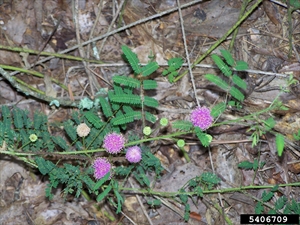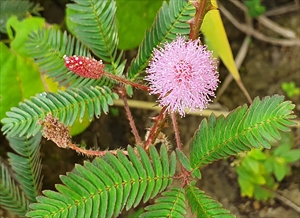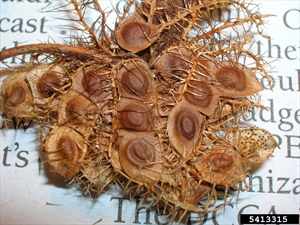Sensitive plant; it is also known as mimosa, common sensitive plant, or touch-me-not.
Pacific Pests, Pathogens and Weeds - Online edition
Pacific Pests, Pathogens & Weeds
Sensitive plant (464)
Mimosa pudica. There are a number of varieties. It is a member of the Fabaceae.
Asia, Africa, North, South and Central America, the Caribbean, Oceania. It is recorded from Australia, American Samoa, Cook Islands, Federated States of Micronesia, Fiji, French Polynesia, Guam, Kiribati, Marshall Islands, Nauru, New Caledonia, Niue, Northern Mariana Islands, Palau, Papua New Guinea, Samoa, Solomon Islands, Tokelau, Tuvalu, Vanuatu, and Wallis & Futuna.
A weed is a native of tropical America.
A common invasive weed of disturbed areas, growing in a variety of soils from coastal to 1300 masl throughout the tropics and sub-tropics. It is found in plantations, pastures, gardens, lawns, roadsides, and wasteland. In both southeast Asia and the Pacific, it is reported as a serious weed of cotton, maize, pineapple, sorghum, soybean, sugarcane, tea, tomatoes, and upland rice. It is tolerant of shading and hence common in plantations of bananas, citrus, coconuts, coffee, oil palm, papaya, and rubber. The seeds are readily attached to animals and humans and this accounts partly for its weediness.
A small prickly shrub, up to 50 cm tall, that creeps or sprawls over the ground (Photo 1). Stems are brown to purple, woody with age, rounded and much-branched, with sharp thorns, 2.5-5 mm long (Photo 2). Leaves, alternate along the stem, with hairy stalks up to 60 mm long, bearing 1-2 pairs leaf-like branches, with 10-50 pairs of dark green elongated leaflets (Photos 3&4). The margins of the leaflets have bristly hairs (Photo 5). The leaves fold up when touched, and at night. Flower stalks, 12-25 mm long, with hairs and thorns, arise from leaf axils; they bear bright purplish-pink, egg-shaped, flower clusters, 9-15 mm across (Photos 5-7). Each flower is about 2 mm long, with four long stamens (male parts) giving the flowers a fluffy look. Seeds are produced in 8-15 mm long seed pods, splitting into 2-4, 1-seeded segments bearing bristles (Photo 8). About 700 seeds are produced by one plant in a year. The root is long and strong.
Spread is by seeds which have bristles and hairs and become attached to the fur of animals, the clothing of humans, or are transferred as a contaminant of soil, sand and gravel. Over long distances, spread is by people moving the plant as an ornamental.
The thorns prevent cattle from feeding on grass where it has become intertwined with the weed. However, this view is not universally held and there are those who maintain that it makes a valuable contribution to pastures as cattle will feed on young plants. There is less doubt that it can causes a problem in forests and plantation crops, and cause lacerations when walking through areas where it is growing and during hand-weeding resulting in painful sores. When dead, it can become a fire hazard and, after fires, may prevent the re-establishment of other species.
Sensitive grass contains mimosine which bacteria convert to a toxin interfering with thyroid function in cattle, and resulting in hair loss (a problem solved in Australia, Fiji, Papua New Guinea and elsewhere by introducing a bacterium that degrades the toxic chemical).
Mimosa has been documented as a source of pollen for honeybees, as a legume in soil improvement and in a wide-range of folk medicines for a large number of conditions, none of which according to CABI have been adopted for main-stream use. Sheep will graze on it.
BIOSECURITY
The risk of introduction is high. Countries not yet infested should consider all likely pathways for entry, and apply quarantine measures accordingly. Particular attention should be given to the risks associated with the trade in mimosa as an ornamental. Seeds are readily available on the internet.
It is among the 10 worst weeds in American Samoa, French Polynesia, Guam, Solomon Islands, and Tonga, and important in Cook Islands, Fiji, New Caledonia, Papua New Guinea, and Samoa. Mimosa pudica is on the Global Invasive Species Database (2020) of information about alien and invasive species that negatively impact biodiversity, managed by the Invasive Species Specialist Group of the IUCN Species Survival Commission.
BIOCONTROL
Waterhouse & Norris state that there is comparatively little known about natural enemies of Mimosa pudica, and no work appears to be current.
CULTURAL CONTROL
- Physical & Mechanical
- Hand weed. On very young plants only; older plants are woody with strong root systems, and they have sharp thorns! Use of a hoe is common practice.
- Do not overgraze. Overgrazing encourages growth of mimosa, but so does too low a stocking rate. Adjust stocking rates so that cattle are forced to eat the weed.
- Use mulch. Placing dried coconut fronds among ginger (and possibly other crops) is a way of controlling the weed.
- Hygiene
- Treat vehicles and farm machinery. If moving from areas where the weed occurs to those weed-free, wash to remove soil. This is equally important if the machinery is being imported into a country or moved within a country. Also, ensure seeds are not carried on clothes between infested and 'clean' areas.
CHEMICAL CONTROL
In Australia, MCPA + terbutryn; fluroxypyr; dicamba; picloram + triclopyr; hexazinone + diuron are registered. In Fiji, 2,4-D; glyphosate.
--------------------
Note, in the EU, and approval to use glyphosate ends in December 2022;; its use after that date is under discussion. Note, neither terbutryn nor hexazinone are approved for use in the EU.
____________________
When using a pesticide, always wear protective clothing and follow the instructions on the product label, such as dosage, timing of application, and pre-harvest interval. Recommendations will vary with the crop and system of cultivation. Expert advice on the most appropriate pesticide to use should always be sought from local agricultural authorities.
AUTHORS Grahame Jackson, Aradhana Deesh & Mani Mua
Adapted from Common sensitive plant (Mimosa pudica) (2018) Weeds of SE Qld and Northern NSW. Lucidcentral. (https://www.lucidcentral.org/editors-pick-animal-and-plant-identification-keys/key-to-weeds-of-se-qld-and-northern-nsw); and additional information from CABI (2019) Mimosa pudica (sensitive plant). Invasive Species Compendium. (https://www.cabi.org/isc/datasheet/34202); and Waterhouse DF, Norris KR (1987) Mimosa pudica Linnaeus. Biological Control Pacific Prospects. Inkata Press, Melbourne; and from Mimosa pudica (2020) Wikipedia. (https://en.wikipedia.org/wiki/Mimosa_pudica). Photos 1&5 Karan A. Rawlins, University of Georgia, Bugwood.org; Photo 4 Shaun Winterton, Aquarium and Pond Plants of the World, Edition 3, USDA APHIS PPQ, Bugwood.org; Photo 7 Forest and Kim Starr, Starr Environmental, Bugwood.org.
Produced with support from the Australian Centre for International Agricultural Research under project HORT/2016/185: Responding to emerging pest and disease threats to horticulture in the Pacific islands, implemented by the University of Queensland, in association with the Pacific Community and Koronivia Research Station, Ministry of Agriculture, Fiji.











